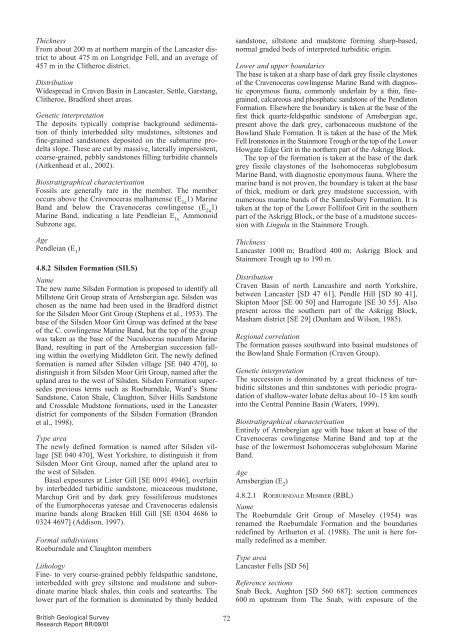A lithostratigraphical framework for the Carboniferous successions ...
A lithostratigraphical framework for the Carboniferous successions ...
A lithostratigraphical framework for the Carboniferous successions ...
Create successful ePaper yourself
Turn your PDF publications into a flip-book with our unique Google optimized e-Paper software.
Thickness<br />
From about 200 m at nor<strong>the</strong>rn margin of <strong>the</strong> Lancaster district<br />
to about 475 m on Longridge Fell, and an average of<br />
457 m in <strong>the</strong> Cli<strong>the</strong>roe district.<br />
Distribution<br />
Widespread in Craven Basin in Lancaster, Settle, Garstang,<br />
Cli<strong>the</strong>roe, Brad<strong>for</strong>d sheet areas.<br />
Genetic interpretation<br />
The deposits typically comprise background sedimentation<br />
of thinly interbedded silty mudstones, siltstones and<br />
fine-grained sandstones deposited on <strong>the</strong> submarine prodelta<br />
slope. These are cut by massive, laterally impersistent,<br />
coarse-grained, pebbly sandstones filling turbidite channels<br />
(Aitkenhead et al., 2002).<br />
Biostratigraphical characterisation<br />
Fossils are generally rare in <strong>the</strong> member. The member<br />
occurs above <strong>the</strong> Cravenoceras malhamense (E 1c 1) Marine<br />
Band and below <strong>the</strong> Cravenoceras cowlingense (E 2a 1)<br />
Marine Band, indicating a late Pendleian E 1c Ammonoid<br />
Subzone age.<br />
Age<br />
Pendleian (E 1 )<br />
4.8.2 Silsden Formation (SILS)<br />
Name<br />
The new name Silsden Formation is proposed to identify all<br />
Millstone Grit Group strata of Arnsbergian age. Silsden was<br />
chosen as <strong>the</strong> name had been used in <strong>the</strong> Brad<strong>for</strong>d district<br />
<strong>for</strong> <strong>the</strong> Silsden Moor Grit Group (Stephens et al., 1953). The<br />
base of <strong>the</strong> Silsden Moor Grit Group was defined at <strong>the</strong> base<br />
of <strong>the</strong> C. cowlingense Marine Band, but <strong>the</strong> top of <strong>the</strong> group<br />
was taken as <strong>the</strong> base of <strong>the</strong> Nuculoceras nuculum Marine<br />
Band, resulting in part of <strong>the</strong> Arnsbergian succession falling<br />
within <strong>the</strong> overlying Middleton Grit. The newly defined<br />
<strong>for</strong>mation is named after Silsden village [SE 040 470], to<br />
distinguish it from Silsden Moor Grit Group, named after <strong>the</strong><br />
upland area to <strong>the</strong> west of Silsden. Silsden Formation supersedes<br />
previous terms such as Roeburndale, Ward’s Stone<br />
Sandstone, Caton Shale, Claughton, Silver Hills Sandstone<br />
and Crossdale Mudstone <strong>for</strong>mations, used in <strong>the</strong> Lancaster<br />
district <strong>for</strong> components of <strong>the</strong> Silsden Formation (Brandon<br />
et al., 1998).<br />
Type area<br />
The newly defined <strong>for</strong>mation is named after Silsden village<br />
[SE 040 470], West Yorkshire, to distinguish it from<br />
Silsden Moor Grit Group, named after <strong>the</strong> upland area to<br />
<strong>the</strong> west of Silsden.<br />
Basal exposures at Lister Gill [SE 0091 4946], overlain<br />
by interbedded turbiditic sandstone, micaceous mudstone,<br />
Marchup Grit and by dark grey fossiliferous mudstones<br />
of <strong>the</strong> Eumorphoceras yatesae and Cravenoceras edalensis<br />
marine bands along Bracken Hill Gill [SE 0304 4686 to<br />
0324 4697] (Addison, 1997).<br />
Formal subdivisions<br />
Roeburndale and Claughton members<br />
Lithology<br />
Fine- to very coarse-grained pebbly feldspathic sandstone,<br />
interbedded with grey siltstone and mudstone and subordinate<br />
marine black shales, thin coals and seatearths. The<br />
lower part of <strong>the</strong> <strong>for</strong>mation is dominated by thinly bedded<br />
British Geological Survey<br />
Research Report RR/09/01<br />
72<br />
sandstone, siltstone and mudstone <strong>for</strong>ming sharp-based,<br />
normal graded beds of interpreted turbiditic origin.<br />
Lower and upper boundaries<br />
The base is taken at a sharp base of dark grey fissile claystones<br />
of <strong>the</strong> Cravenoceras cowlingense Marine Band with diagnostic<br />
eponymous fauna, commonly underlain by a thin, finegrained,<br />
calcareous and phosphatic sandstone of <strong>the</strong> Pendleton<br />
Formation. Elsewhere <strong>the</strong> boundary is taken at <strong>the</strong> base of <strong>the</strong><br />
first thick quartz-feldspathic sandstone of Arnsbergian age,<br />
present above <strong>the</strong> dark grey, carbonaceous mudstone of <strong>the</strong><br />
Bowland Shale Formation. It is taken at <strong>the</strong> base of <strong>the</strong> Mirk<br />
Fell Ironstones in <strong>the</strong> Stainmore Trough or <strong>the</strong> top of <strong>the</strong> Lower<br />
Howgate Edge Grit in <strong>the</strong> nor<strong>the</strong>rn part of <strong>the</strong> Askrigg Block.<br />
The top of <strong>the</strong> <strong>for</strong>mation is taken at <strong>the</strong> base of <strong>the</strong> dark<br />
grey fissile claystones of <strong>the</strong> Isohomoceras subglobosum<br />
Marine Band, with diagnostic eponymous fauna. Where <strong>the</strong><br />
marine band is not proven, <strong>the</strong> boundary is taken at <strong>the</strong> base<br />
of thick, medium or dark grey mudstone succession, with<br />
numerous marine bands of <strong>the</strong> Samlesbury Formation. It is<br />
taken at <strong>the</strong> top of <strong>the</strong> Lower Follifoot Grit in <strong>the</strong> sou<strong>the</strong>rn<br />
part of <strong>the</strong> Askrigg Block, or <strong>the</strong> base of a mudstone succession<br />
with Lingula in <strong>the</strong> Stainmore Trough.<br />
Thickness<br />
Lancaster 1000 m; Brad<strong>for</strong>d 400 m; Askrigg Block and<br />
Stainmore Trough up to 190 m.<br />
Distribution<br />
Craven Basin of north Lancashire and north Yorkshire,<br />
between Lancaster [SD 47 61], Pendle Hill [SD 80 41],<br />
Skipton Moor [SE 00 50] and Harrogate [SE 30 55]. Also<br />
present across <strong>the</strong> sou<strong>the</strong>rn part of <strong>the</strong> Askrigg Block,<br />
Masham district [SE 29] (Dunham and Wilson, 1985).<br />
Regional correlation<br />
The <strong>for</strong>mation passes southward into basinal mudstones of<br />
<strong>the</strong> Bowland Shale Formation (Craven Group).<br />
Genetic interpretation<br />
The succession is dominated by a great thickness of turbiditic<br />
siltstones and thin sandstones with periodic progradation<br />
of shallow-water lobate deltas about 10–15 km south<br />
into <strong>the</strong> Central Pennine Basin (Waters, 1999).<br />
Biostratigraphical characterisation<br />
Entirely of Arnsbergian age with base taken at base of <strong>the</strong><br />
Cravenoceras cowlingense Marine Band and top at <strong>the</strong><br />
base of <strong>the</strong> lowermost Isohomoceras subglobosum Marine<br />
Band.<br />
Age<br />
Arnsbergian (E 2 )<br />
4.8.2.1 roeBurNDale memBer (rBl)<br />
Name<br />
The Roeburndale Grit Group of Moseley (1954) was<br />
renamed <strong>the</strong> Roeburndale Formation and <strong>the</strong> boundaries<br />
redefined by Arthurton et al. (1988). The unit is here <strong>for</strong>mally<br />
redefined as a member.<br />
Type area<br />
Lancaster Fells [SD 56]<br />
Reference sections<br />
Snab Beck, Aughton [SD 560 687]: section commences<br />
600 m upstream from The Snab, with exposure of <strong>the</strong>

















